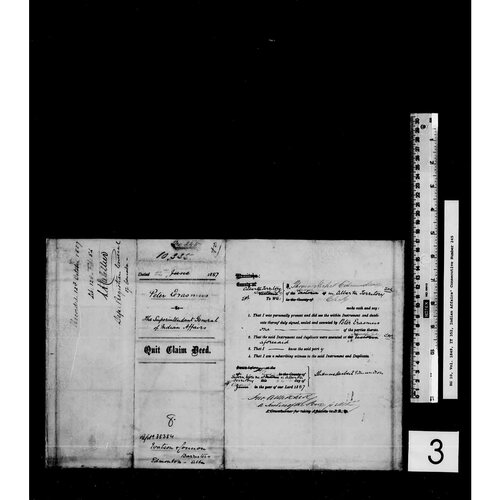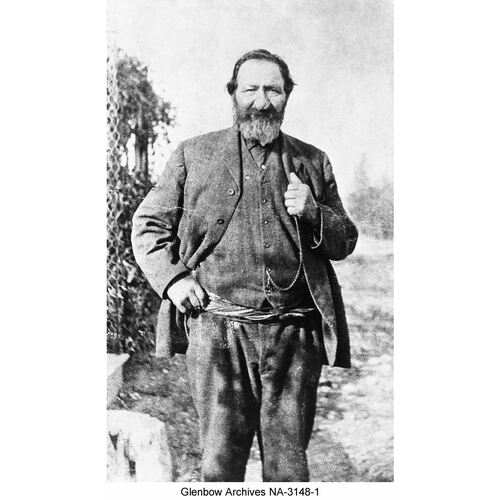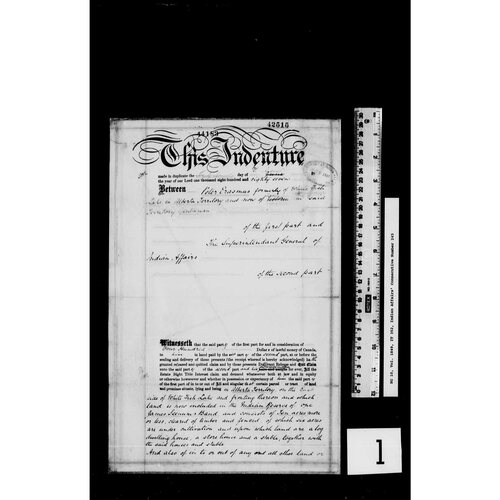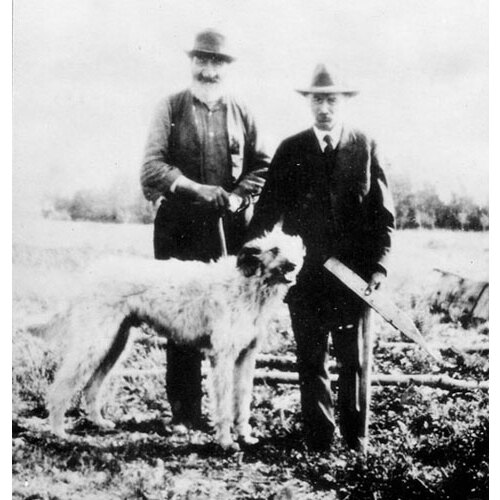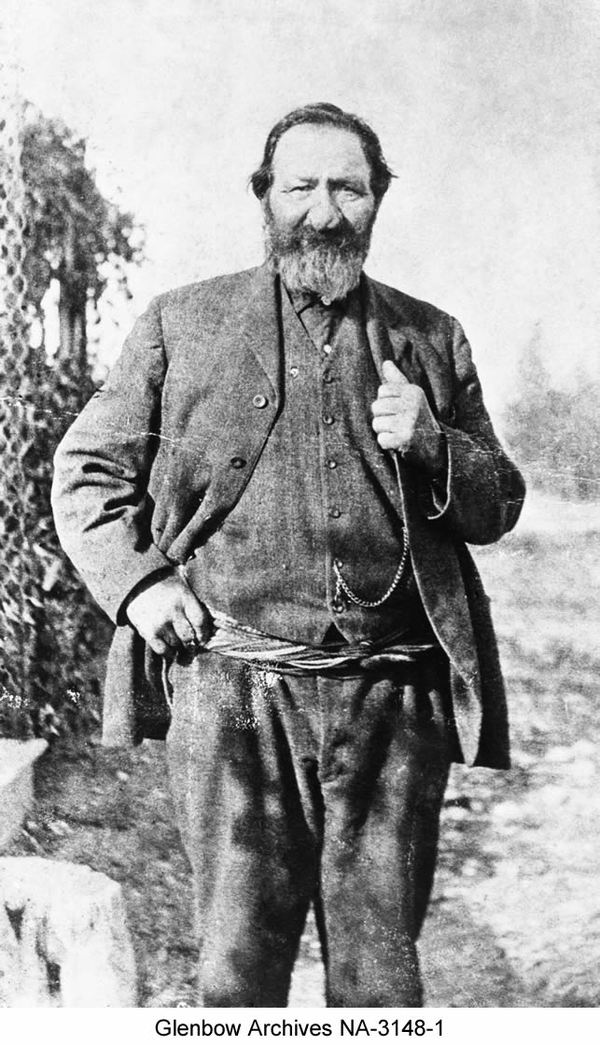
Source: Link
ERASMUS, PETER, farmer, teacher, missionary assistant, hunter, guide, trader, interpreter, and chronicler; b. 27 June 1833 in the Red River settlement (Man.); m. first 1864 Charlotte Jackson (d. 1880) at Whitefish Lake (Alta), and they had four sons and two daughters; m. there secondly 1882 Mary Stanley (d. 1891), and they had three daughters; he may have had a son prior to his first marriage, and he adopted a son; d. 28 May 1931 at Whitefish Lake.
Peter Erasmus was one of eight children born to Peter Erasmus, a Danish settler at Red River, and Catherine (Kitty), a Métis. She was a sister of Henry Budd*, the first aboriginal catechist for the Church of England in Rupert’s Land and a descendant of fur traders William Hemmings Cook* and Matthew Cocking*. Peter began school at the age of seven, under the tutelage of James Settee* and Budd. Following the death of his father in 1849, he took over the family farm, but in 1851 he left to work as a schoolmaster for his uncle Henry at Christ Church mission in The Pas. Successful in this position, he was encouraged to study for the Anglican ministry at St John’s Collegiate School in Red River.
Erasmus admitted, however, that he felt no call to the ministry; as he put it, “My prayers had no substance.” An alternative presented itself during his third term when he was offered a chance to serve as assistant to the Reverend Thomas Woolsey of the Methodist Church. Erasmus seized the opportunity despite his previous close association with the Anglicans. He joined Woolsey in 1856 and participated in re-establishing missions at Fort Edmonton (Edmonton) and Pigeon Lake (Alta). According to Woolsey, he was a particularly effective interpreter, and his hunting skills helped keep the mission communities fed.
In 1858 Erasmus agreed to join Dr James Hector as an outfitter and hunter in his travels with the western expedition of John Palliser*. Erasmus left Hector’s party in August 1859 when, because of the lateness of the season, he and Hector disagreed about the prudence of a proposed journey through Howse Pass (Alta) to the Columbia River. Instead, Erasmus went to look for gold around Fort Colvile (near Colville, Wash.). In 1861 he was working for Woolsey and Henry Bird Steinhauer* at Smoking (Smoky) Lake mission, northeast of Fort Edmonton. Two years later he met the Reverend George Millward McDougall* and his son John Chantler*, and was hired by them as a guide and interpreter. They found him invaluable. John McDougall described him as “an ‘A1’ interpreter,” and much of the early success of their mission at Victoria (Pakan, Alta) was based on Erasmus’s abilities as a hunter and traveller.
Erasmus stopped assisting the McDougalls in 1865 following a dispute over pay. He then settled with his wife, Charlotte, at Whitefish Lake on land given to them by James Seenum (Pakan), the leader of the local Cree band. The Erasmuses supported themselves by trapping. A chance encounter in Red River with an old school acquaintance from St John’s – either William or Colin Inkster – led to a proposal that Peter take back trade goods on commission. He thus began a new career as an independent trader at Whitefish Lake.
In 1876 Erasmus was approached by Mistawāsis (Big Child) and Ahtahkakoop (Star Blanket) to act as their interpreter at Fort Carlton (Sask.) during the negotiation of Treaty No.6 [see Kamīyistowesit*]. Although hired to act for the Plains Cree, he took on a much larger role in the translation of talks because the government translators, Peter Ballendine and the Reverend John McKay, seemingly lacked his language skills. An accomplished linguist, he was fluent in English and several Cree dialects, as well as Ojibwa, Stoney (Nakoda), and Blackfoot.
Erasmus’s memoirs include one of the few surviving accounts of the treaty process written by someone not associated with an official government party, and it offers significant details about what First Nations groups discussed in behind-the-scenes councils. For example, Erasmus indicates that a speech by Mistawāsis was crucial in persuading a number of otherwise reluctant band leaders to accept the proposed treaty. Erasmus also acted as a translator in the talks on Treaty No.6 at Fort Pitt and the adhesions to the treaty signed there in 1877. Later, in 1884, he assisted James Seenum in his efforts to get the boundaries of the Saddle Lake Reserve (Alta) extended.
In the years after 1876 Erasmus had worked for the federal Department of Indian Affairs as a “storeman and interpreter” for the Saddle Lake and Edmonton agencies. This time was an uneasy period in his life. Charlotte died in 1880 and Erasmus admitted in his memoirs that, by the early 1880s, he was “tired of travel” and eager to settle down with his family and “old friends among the Indians” in the Whitefish Lake area. An offer of work buying furs for the Hudson’s Bay Company at Whitefish and Saddle lakes made this wish possible, and by 1882 he had resumed activity as a small trader.
Erasmus’s last major brush with history occurred in 1885 when he played a part in keeping members of the bands in the Saddle Lake agency out of hostilities during the North-West uprising [see Mistahimaskwa*]. His adopted son, Peter Shirt, was even more prominent in this effort. Peter Shirt’s prophetic dream of trouble and his dogged determination to act on what it foretold, as recounted by Erasmus, underlines the very different cultural worlds that coexisted in the northwest in 1885 and that Erasmus helped to bridge.
After 1885 Erasmus taught school at Victoria, Whitefish Lake, and Goodfish Lake. He also continued to work for Indian Affairs; he had a sinecure, arranged by interior minister Frank Oliver, as “assistant rationer” at Gleichen on the Blackfoot Reserve from 1909 to 1912. Later still, the government paid Erasmus a modest pension for his years with Indian Affairs and his role as a translator on Treaty No.6. Peter Erasmus died at Whitefish Lake in 1931.
At the age of 87, Erasmus had agreed to share his history with Henry Thompson, a local Métis author and newspaperman. The resulting typescript, which stops in 1885, was not immediately published but the Glenbow-Alberta Institute of Calgary later acquired it and in 1976 issued an edited version, Buffalo days and nights. Although some readers have questioned Erasmus’s ability to recall exact conversations years later, historians have found that his general descriptions of persons and events are usually supported by other evidence. Buffalo days and nights thus remains one of the most significant first-hand accounts of life in western Canada in the 19th century, and one of the few based on direct knowledge of the First Nations and Métis peoples.
Erasmus’s memoir was published as Buffalo days and nights: Peter Erasmus as told to Henry Thompson, intro. I. [M.] Spry (Calgary, 1976; repr. 1999).
AM, HBCA, B.60/a/30–32 (Fort Edmonton Post Journals, 1858–62). GA, M 474, M 475, M 476, M 477, M 5908; M 729 (George and John McDougall family fonds); M 3525; M 4497 (mfm.); M 7144-314,000. Glenbow Library (Calgary), Peter Erasmus clipping file. Canada, Indian treaties and surrenders … [1660–1906] (3v., Ottawa, 1891–1912; repr. Toronto, 1971), 2. G. H. Gooderham, “Peter Erasmus,” Alberta Hist. (Calgary), 36 (1988), no.2: 16–19. J. [C.] McDougall, Parsons on the plains, ed. Thomas Bredin (Toronto, 1971). Alexander Morris, The treaties of Canada with the Indians of Manitoba and the North-West Territories … (Toronto, 1880; repr. 1971 and 2000). Wesleyan Missionary Notices (London), 3rd ser., 8 (1861)–11 (1864). Wesleyan Missionary Notices, Canada Conference (Toronto), nos.12 (May 1857)–17 (February 1859). Thomas Woolsey, Heaven is near the Rocky Mountains: the journals and letters of Thomas Woolsey, 1855–1869, ed. H. A. Dempsey (Calgary, 1989).
Cite This Article
Michael Payne, “ERASMUS, PETER,” in Dictionary of Canadian Biography, vol. 16, University of Toronto/Université Laval, 2003–, accessed December 21, 2025, https://www.biographi.ca/en/bio/erasmus_peter_16E.html.
The citation above shows the format for footnotes and endnotes according to the Chicago manual of style (16th edition). Information to be used in other citation formats:
| Permalink: | https://www.biographi.ca/en/bio/erasmus_peter_16E.html |
| Author of Article: | Michael Payne |
| Title of Article: | ERASMUS, PETER |
| Publication Name: | Dictionary of Canadian Biography, vol. 16 |
| Publisher: | University of Toronto/Université Laval |
| Year of publication: | 2014 |
| Year of revision: | 2014 |
| Access Date: | December 21, 2025 |


